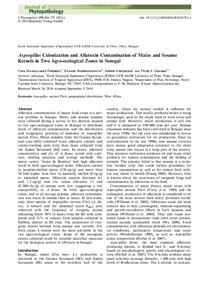| dc.contributor.author | Diedhiou, P.M. |
| dc.contributor.author | Bandyopadhyay, Ranajit |
| dc.contributor.author | Atehnkeng, J. |
| dc.contributor.author | Ojiambo, P.S. |
| dc.date.accessioned | 2019-12-04T11:08:47Z |
| dc.date.available | 2019-12-04T11:08:47Z |
| dc.date.issued | 2011 |
| dc.identifier.citation | Diedhiou, P.M., Bandyopadhyay, R., Atehnkeng, J. & Ojiambo, P.S. (2011). Aspergillus colonization and aflatoxin contamination of maize and sesame kernels in two agro‐ecological zones in Senegal. Journal of Phytopathology, 159(4), 268-275. |
| dc.identifier.issn | 0931-1785 |
| dc.identifier.uri | https://hdl.handle.net/20.500.12478/1911 |
| dc.description.abstract | Aflatoxin contamination of major food crops is a serious problem in Senegal. Maize and sesame samples were collected during a survey in five districts located in two agro-ecological zones in Senegal to determine levels of aflatoxin contamination and the distribution and toxigenicity potential of members of Aspergillus section Flavi. Maize samples from the Guinea Savannah zone (SG) exhibited lower aflatoxin content and colony-forming units (cfu) than those collected from the Sudan Savannah (SS) zone. In maize, aflatoxin concentration and cfu of A. flavus varied with cultivars, shelling practices and storage methods. The maize variety Jaune de Bambey had high aflatoxin levels in both agro-ecological zones. Aflatoxin content in machine-shelled maize (120 ng ⁄ g) was more than 10-fold higher than that in manually shelled (8 ng ⁄ g) or unshelled maize. Aflatoxin content (between 0.1
and 1.2 ng ⁄ g) and cfu values (between 13 and 42 000 cfu ⁄ g) of sesame were low, suggesting a low susceptibility to A. flavus. In both agro-ecological zones, and in all storage systems, aflatoxin contamination was lower in sesame than in maize. In this study,
only three species of Aspergillus section Flavi (A. flavus, A. tamarii and the unnamed taxon SBG) were observed with the frequency of toxigenic strains remaining below 50% in maize from the SG zone compared with 51% of isolates from samples collected in Sedhiou district in SS zone. The proportion of toxigenic strains isolated from sesame was variable. For both crops, L-strains were the most prevalent in the two agro-ecological zones. Some of the atoxigenic strains collected could be valuable microbial resources for the biological control of aflatoxin in Senegal. |
| dc.description.sponsorship | International Fund for Agricultural Research |
| dc.format.extent | 268-275 |
| dc.language.iso | en |
| dc.subject | Aspergillus Flavus |
| dc.subject | Geographical Distribution |
| dc.subject | Aflatoxins |
| dc.subject | Maize |
| dc.subject | Agro-Ecological Zones |
| dc.subject | Sesame |
| dc.title | Aspergillus colonization and aflatoxin contamination of maize and sesame kernels in two agro-ecological zones in Senegal |
| dc.type | Journal Article |
| dc.description.version | Peer Review |
| cg.contributor.affiliation | Université de Thiès |
| cg.contributor.affiliation | International Institute of Tropical Agriculture |
| cg.contributor.affiliation | North Carolina State University |
| cg.coverage.region | Africa |
| cg.coverage.region | West Africa |
| cg.coverage.country | Senegal |
| cg.isijournal | ISI Journal |
| cg.authorship.types | CGIAR and developing country institute |
| cg.iitasubject | Aflatoxin |
| cg.iitasubject | Maize |
| cg.iitasubject | Plant Production |
| cg.journal | Journal of Phytopathology |
| cg.howpublished | Formally Published |
| cg.accessibilitystatus | Limited Access |
| local.dspaceid | 85027 |
| cg.targetaudience | Scientists |
| cg.identifier.doi | http://dx.doi.org/10.1111/j.1439-0434.2010.01761.x |

